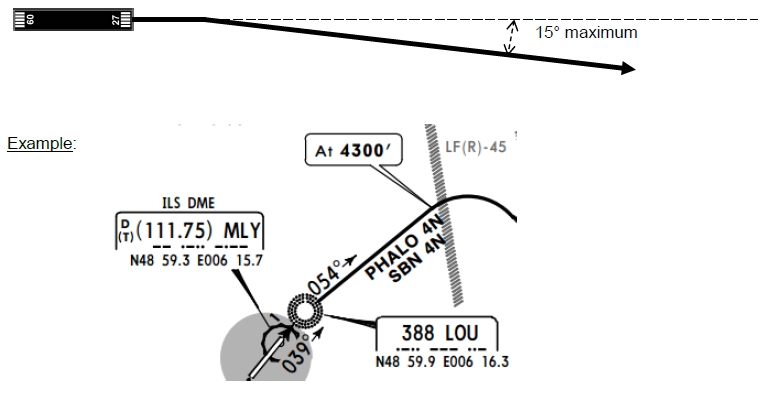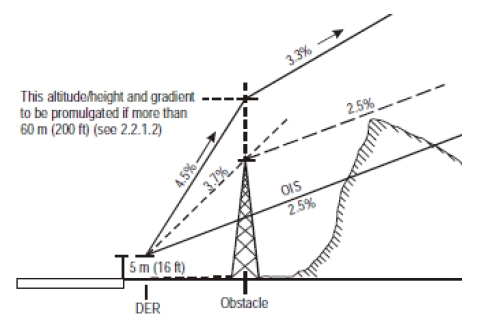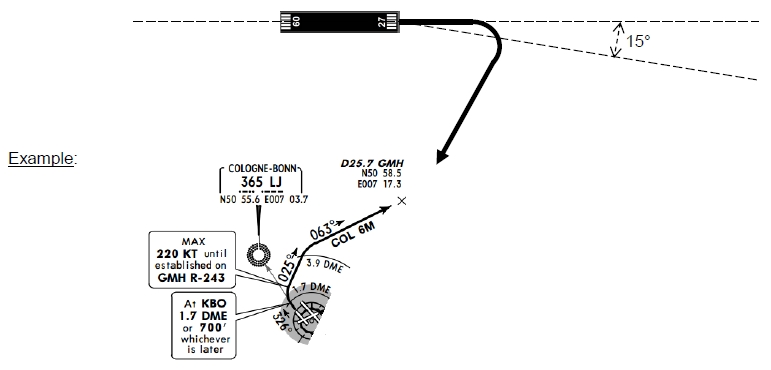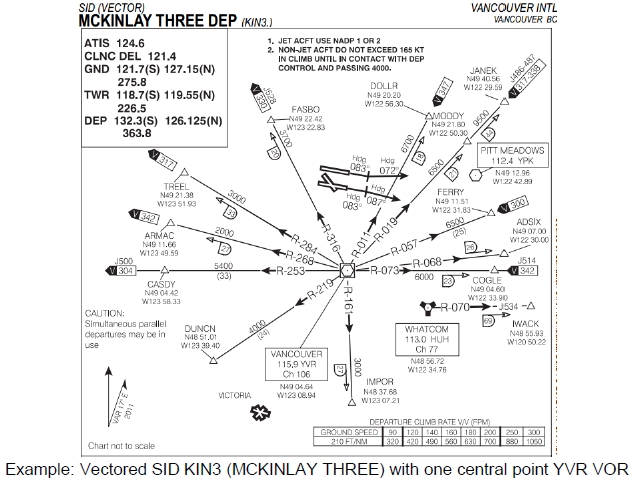¶ Introduction
The design of an instrument departure procedure is, in general, dictated by the terrain surrounding the aerodrome. It may also be required to provide for air traffic control (ATC) requirements in the case of SID routes. These factors in turn influence the type and siting of navigation aids in relation to the departure route. Airspace restrictions may also affect the routing and siting of navigation aids.
Departure procedures may be developed to procedurally separate air traffic. The procedure may be accompanied with altitude/flight level restrictions that are not associated with any obstacle clearance requirements but are developed to separate arriving and departing aircraft procedurally.
In order to ensure acceptable clearance above obstacles during the departure phase, instrument departure procedures (for IFR flights) may be published as specific routes to be followed or as omnidirectional departures. A departure procedure is established for each runway where instrument departures are expected to be used. It will include procedures for the various categories of aircraft.
¶ Non-prescribed departure routes
At many aerodromes, a prescribed departure route is not required for ATC purposes. Nevertheless, there may be obstacles in the vicinity of some aerodromes that have to be considered in determining whether restrictions to departures are to be prescribed. In such cases, departure procedures may be restricted to a given sector(s) or may be published with a procedure design gradient in the sector containing the obstacle.
¶ Omnidirectional departures
Where no suitable navigation aid is available, the criteria for omnidirectional departures are applied. Omnidirectional departures may specify sectors to be avoided.
These departures can be published with climbing gradients and significant obstacles. These departures assume that all engines are operating.
- Definition:
- DER = departure end of the runway which is the end of the area declared suitable for take-off (i.e. the end of the runway including clearway as appropriate).
- PDG = procedure design gradient = published climbing rate
¶ Standard instrument departures - SID
A standard instrument departure (SID) is a departure procedure with published tracks on departure charts that is normally developed to accommodate as many aircraft categories as possible.
These departures can be published with charts and diagrams or, with text description only.
The SID begins from the departure end of the runway (DER) and terminates at the first fix, facility or waypoint of the en-route phase of the flight following the departure procedure.
Standard departure clearances for departing aircraft shall contain the following items:
- Aircraft identification
- Clearance limit, normally destination aerodrome
- Designator of the assigned SID (if applicable) and the applicable runway
- Initial level (except when this element is included in the SID description)
- Allocated SSR code
- Other necessary instructions or information not contained in the SID description (example frequency change)
For a standard instrument departure, all tracks, point fixes and altitude/height required in the procedure are published.
The following information is also promulgated:
- Significant, highest and closest obstacles in the departure area (position and height)
- Procedure design gradients (PDG) greater than 3.3%
- Altitude/height at which a gradient is specified.
- Altitude to be achieved during the departure when over heading significant points
- All navigation facilities (navaids), fixes or waypoints, radials and DME distances.
There are two basic types of SID:
- Straight departure
- Turning departure
When a departing aircraft on a SID is cleared to climb to a level higher than the initially cleared or the level(s) specified in a SID, the aircraft shall follow the published vertical profile of a SID, unless such restrictions are explicitly cancelled by ATC.
¶ Straight departure
A straight departure is one in which the initial departure track is within 15° of the alignment of the runway centre line.

When obstacles exist, procedure design gradients (PDG), greater than 3.3%, may be specified.
When such a gradient is specified, the altitude height to which it extends shall be promulgated.

Gradients to a height of 60m (200ft) or less are not specified.
¶ Turning departures
When a departure route requires a turn of more than 15°, it is called a turning departure.
In a turning departure, a straight flight is assumed until reaching an altitude/height or at least 120m (394ft) for aircraft, and 90m (295ft) for helicopters.

Procedure turns are normally initiated at a point 600m from the beginning or the runway. However, in some cases, turns may not be initiated before the departure end of the runway (DER), and this information will be noted on the departure chart.
For category H procedures, procedure turns can be initiated 90m (295ft) above the elevation of the airfield.
¶ Turn parameters
The turns may be defined as occurring at:
- An altitude or a height
- A fix or a facility
The turn speeds are:
- Final missed approach speed increased by 10% to account for increased aircraft mass in departure
- Intermediate missed approach speed increased by 10% where acceptable terrain clearances cannot be provided. In such cases the procedure is annotated on charts.
Where location and height of obstacles preclude the construction of a turning departure, all information shall be specified on charts and developed by competent authority.
¶ Flight tolerance
The procedure must be constructed for all conditions of flight. The table below gives the maximum turn speed in function of aircraft category:
| Aircraft category | Maximum speed km/h | Maximum speed KT |
|---|---|---|
| A | 225 | 120 |
| B | 305 | 165 |
| C | 490 | 265 |
| D | 540 | 290 |
| E | 560 | 300 |
| H | 165 | 90 |
The wind conditions are maximum 95% of probability wind on an omnidirectional basis, where statistical wind data are available or omnidirectional 56 km/h (30kt).
The pilot reaction time taken is 3 seconds and the bank establishment time is 3 seconds.
¶ Specific SID
Some standard instrument departures are published but no route is described. These SIDs are mainly linked with air traffic controllers who give radar vectors during the departure procedure in busiest areas. In general in these vectored SIDs, there is initial climb and heading and one or several exit points.
The air traffic controller will provide radar vectors or direct to fix/radio navigation aid clearance and instructions in function of arriving traffic.

¶ Omnidirectional departures
In cases where no track guidance is provided, departure procedures are designed using the omnidirectional method. The omnidirectional departure normally allows departure in any direction.
Where obstacles do not permit development of an omnidirectional procedure, it is necessary to fly a standard instrument departure or ensure that ceiling and visibility will permit obstacles to be avoided by visual means.
The departure procedure begins at the departure end of the runway (DER).
Omnidirectional departure restrictions are:
- Sector to be avoided
- Sector having minimum procedure design gradient and/or minimum altitude
When more than one sector is involved, the published minimum gradient will be the highest of any sector allowed.
Since the point of lift-off will vary, the departure procedure assumes that a turn at 120m (194ft) above the elevation of the airfield is not initiated sooner than 600m from the beginning of the runway. However, in some cases turns may not be initiated before the DER or a specified point (this information will be noted on the departure chart).
For category H procedures, procedure turns can be initiated 90m above the elevation if the DER and the earliest initiation point are at the beginning of the runway.
¶ Procedure design gradient
Unless otherwise specified, omnidirectional departure procedures assume a 3.3% (5% for Helicopters) PDG and a straight climb on the extended runway centre line, until reaching 120m (394ft) (90m (195ft) for Helicopters).
The omnidirectional departure procedure is designed using any one of a combination of the following:
| Procedure | Minimum PDG | Straight Climbing altitude\ before initiate a turn in any direction |
|---|---|---|
| Standard with 90m (295ft) of obstacle clearance | 3.3% | 120m (394ft) |
| Specified turn altitude height | 3.3% | Published altitude |
| Specified procedure design gradient | Published PDG | Published altitude |
| Sector departure Where obstacle exists (the procedure may identify the concerned allowed sectors) | Published PDG | Published altitude |
¶ Specific omnidirectional departure
The vectored departure is a type of omnidirectional departure that implies for a pilot to follow vectors given by air traffic controllers.
The pilot shall respect the standard procedure gradient and altitude.
Example: "BAW1133, cleared to destination airfield, after take-off, turn right heading 110°, climb flight level 180, squawk 6373"
A detailed departure procedure shall be given step by step by the controller on ground. This is also a non-published omnidirectional departure.
Example: "BAW1133, cleared to destination airfield, after take-off, climb straight ahead. At 2000ft turn right heading 020° and intercept radial 210° of NKT VOR outbound and continue climb to FL100. At 23NM DME NKT, turn direct OMLET, squawk 6373"
¶ Additional points for departure
¶ Reduced power take-off
The use of automatic take-off thrust control system (ATTCS) and noise abatement procedures needs to be taken into consideration by the pilot.
Reduced power take-off should not be required in adverse operating conditions such as:
- Adversely affected runway conditions
- Horizontal visibility is less than 1.9km (1NM)
- Crosswind component of the wind including gusts greater than 28km/h (15kt)
- Tailwind component of the wind including gusts greater than 9km/h (5kt)
- Reported or forecasted wind shear
- Thunderstorms presence during approach or departure routes
¶ Climb clearance above level specified in SID
When traffic conditions permit it, ATC may clear aircraft above the levels specified in SID given in the initial clearance.
In that situation, the aircraft shall follow the published vertical profile of a SID, unless such restrictions are explicitly cancelled by ATC.
- ICAO Documentation 8168 - Aircraft Operations - Volume I - Flight Procedures - 6th Edition 2010 - Section 3
- VID 150259 - Author
- VID 531824 - Wiki integration
- VID 496402 - Wiki.js integration